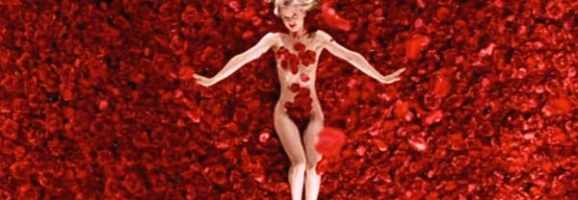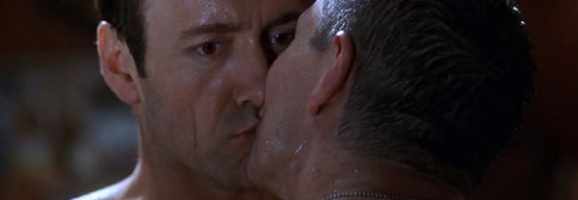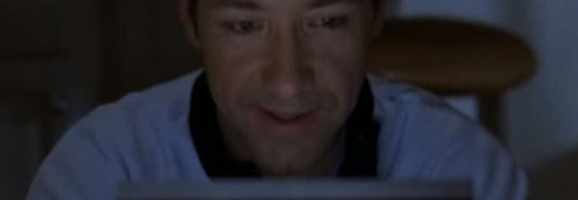American Beauty: The Color Red and the Power of the Visual Image

Given we were told by Lester Burnham in the opening shot of American Beauty that he was going to die, the ending was, in some ways, already spoiled. However, it is much more than the action that sells the climax of the film, images and music come together to form a truly beautiful and poignant culmination of the various character arcs, without the need for explicit dialogue or torrents of exposition.
The late Roger Ebert once said this of the film:
All of these emotional threads come together during one dark and stormy night, when there is a series of misunderstandings so bizarre they belong in a screwball comedy. And at the end, somehow, improbably, the film snatches victory from the jaws of defeat for Lester, its hero. Not the kind of victory you’d get in a feel-good movie, but the kind where you prove something important, if only to yourself.
This is perhaps the telling trait of the picture; the ‘beauty’ in American Beauty. The film is heavy in its final act, when for the most part it had been an almost light-hearted and comical look at the trials and tribulations of suburban America. But the ease and mastery of such emotional significance is – not only a credit to the actors and director (Sam Mendes) – the mark of a razor-sharp script and a screenwriter that is really clued in on his craft. Taking his dialogue and wonderful narration out of the equation gives to such a statement, as story entirely capable of telling the story through visuals alone.
Perhaps the first thing to focus on first, is the use of color and motif. Throughout the entire film, the rose, the American Beauty, had often been a symbol of Lester’s lust and desire for Angela. In his fantasies, the girl is shrouded in the roses, covering her body, betraying the fact that these are, in fact, his passionate musings rather than reality. When Lester is killed however, the viewer can spot a bunch of roses set on the counter-top next to his body. The image is striking; because the flower had been so associated with sexuality and infatuation, it seems somewhat odd for it to reappear in death.

What does this suggest? What does it mean? Well, it could be any of a number of things. It has to be reminded that this is not the first time the audience sees these flowers, they’re a recurring motif throughout in fact. With them showing up again here, in a non-sexual scenario (and indeed, in real-life) it could be said they symbolize the contributing factor as to why Lester had to be killed. It was his lust. His dissatisfaction with a mundane existence. His desire to shrug off the responsibilities of a materialistic way of life, and the way he approached the task of weathering the storm that was a mid-life crisis. These are the feelings and emotions the American Beauty represents and its presence in this scene solidify the theory that these are the things that led Lester to his untimely death.
It’s almost like Lester’s lust for Angela lit the fuse on the entire downward spiral of events. If he hadn’t become obsessed with her, he wouldn’t have started working out. If he hadn’t started working out, Colonel Fitts wouldn’t have spotted him working out naked. If Colonel Fitts hadn’t spotted him, he wouldn’t have thought his son, Ricky, was sleeping with him. Then he wouldn’t have come out as gay and tried to kiss Lester; and if he hadn’t done that, he wouldn’t have been driven to kill him. It was beauty killed the beast.

However, let us not forget, the significance the color red represents in cinema – danger. Why is this so? Is it because it’s the color of blood? Film writer Jim Emerson draws our attention to a Jean-Luc Godard quote ‘it’s not blood, it’s red’ in reference to his 1965 film Pierrot le Fou. Perhaps this is why the color works so well in that respect, it is symbolic of blood, and therefore, a subconscious indicator of death and danger.
That certainly is the case for the closing sequence in American Beauty. Not only does the color of the flowers, indicate the impending demise of Lester Burnham, but it also cements itself in a number of other shots to build suspense and string the audience along to subconsciously question which character killed the protagonist. Each supporting character in the aftermath of Lester’s death is wearing or near something that is red. An even further analysis could suggest that the amount of red shown in each shot strings us along as the murderer’s identity is slowly revealed.
For example, Angela puts on red lipstick in the bathroom when the shot goes off. Ricky and Jane are lying on red-colored bed sheets. Carolyn is wearing a red dress – and holding a gun – which leads us to believe it may be her. Finally, we see Colonel Fitts caked in blood with the murder weapon. The color becomes more and more prominent as we inch towards the killer, which could be read as ever-growing hints as to the likelihood of these characters being the executioner (Angela the least, Colonel Fitts the most).
Color and props however, are not the only things that really progress the story and more importantly, the message. One has to think of camera angles, camera work and editing and their ability to work in tandem. When the gun is pressed to Lester’s head, the camera pulls away from the gun and past the American Beauties before the shot is fired. Not only does this add to the ambiguity of the scene, it also sets up the cinematic guess-who that follows.
In a similar camera movement, the camera tracks sideways as each character here’s the shot, passing them by in that fleeting moment. Not only does this chronicle their reaction to the sound, it helps clear their name of any wrongdoing. However it also sets up the flashback sequence. As the camera drifts across the sky, it drifts across the cast of characters, their reactions and ultimately drifts to the killer’s identity. This is where the editing really helps tell the viewer what is going on. Scenes from Lester’s past are spliced with the current chain of events, indicated by a change of color palette to black and white. This gives a sense of what it feels like for Lester as his life flashes before his very eyes. He is looking back on his fondest memories in his closing moments.

However, does this perhaps say something more? These minute windows into a past we have never seen or been a part of until now. The only thing we have known throughout the film is Lester’s continuing dissatisfaction with the materialistic tendencies of ‘nineties America. This is what Ebert was alluding to in his critique of the film. As Lester dies, he snatches from life those few things that make you the happiest – or the most content. It was never about the couch, or the ass-kissing for him (‘it’s all just stuff’ he quips earlier in the film), no, for Lester it was about redefining yourself as something that matters, something visible but with a feeling so intangible. Just like the plastic bag floating through the wind in final shot, he is concerned with only existing, being whisked along on this thing called life – and he was there to enjoy the ride. Think of it like a Fight Club for the middle-class.
Alan Ball and Sam Mendes had something truly important to say with American Beauty – it’s just amazing that they were able to do so with nothing more than such beautiful imagery.
What do you think? Leave a comment.











Really well done. Especially with the play between the intangible and the tangible… American Beauty pinpoints exactly the issues with just “existing”. People must find their own satisfaction in things that are intangible – I really commend Dale on writing about this.
Great exploration into how unstable the symbol of redness is within the movie. A color that could represent erotic as well as the blood of violence. In all cases, however, it seems to represent a “way out” of the banalities of materialistic existence in nineties America, even at the risk of total demise. Great work!
Great movie with a great message. I think it’s about looking beyond the surface. It’s easy to look at any of the characters in the film and categorize them into whatever cliches they seem to fit, but if you look at any character in the film you can see how they change from beginning to end. Ultimately, though, I believe it’s about how everyone is the same in their struggles though they may be different in personality or surface-level appearance.
After viewing this film I come up with this message:
– The film is called “American BEAUTY” for a reason it’s about different point of viewing the beauty around the world. In this film the charachters goes for 2 point of view : Outer Beauty and Inner Beauty. The film make us see the pros and the cons of this two different way of seeing the world around us and they’re kind of the opposite, in fact the charachters that stand for the Outer Beauty tend to be liars (kind of dirty inside) and ignore the Inner Beauty of the things instead the ones that tend to see the Inner Beauty of the things are pure and kind but they’re wathced with contempt by the society for their lack of Outer Beauty. The only charachter that is different from the others is Lester Burnham, he represent the travel from understanding the Inner Beauty instead of the Outer and it’s pretty much the meaning of the film that wants to let us change our way of seeing the world by his Outer Beauty and to understand the beauty that also simple things , like a flying plastic bag , could have.
IMO this film is one of the best film ever done, it has to be watched by everyone it really opens up a world that was probably inner before!
I agree, and as far as “looking beyond the surface,” I think it’s important to note that the title also speaks to this theme (which Collen also says). American Beauty is a type of rose and rose stems tend to rot. Their flowers, however, may remain healthy-looking and beautiful even as the bottom of the plant is dying. Similarly, the “beauty” of American suburban universe in this film masks the discontent/dissatisfaction/”ugliness” of its inhabitants. This film is amazing and its title and content is open to so many interpretations. This article is a really fantastic exploration.
If only I’d be old enough to understand an appreciate this kind of movie enough to have gone to the cinema to see it.
I wrote an essay about American Beauty in my philosophy class, and how the color red could be affiliated with the concept of existentialism. It is interesting how the color red could be associated to not only death, but lifee as well. Wonderful article.
I wrote an essay in my philosophy class about American Beauty and how the color red that appears throughout it could be affiliated with the concept of existentialism. Wonderful and thought-provoking article.
American Beauty is one of my favorite movies ever! I’m actually writing one of my final papers on it, probably about the different meanings of the reoccurring roses. Anyway, I was really interested in what you had to say about the movie. Very well written article!
Really liked your analysis on the motif of red in the film–even your ability to point at something as seemingly insignificant as a bag floating away in the wind and turn it into something significant to consider in the overall context of the film is pretty impressive. I haven’t seen the film yet but I’ll definitely check it out. Thanks for the read!
I was immediately intrigued by the title and this article did not disappoint. Color theory always interests me and it’s interesting how red serves as both a symbol of desire and warning in American Beauty. As you pointed out, the roses show Lester’s desire for romance with his daughter’s friend but it also the color of blood which is why roses could have been included in Lester’s death scene. While I view the roses serve as a remembrance as the very thing that was keeping him alive, your point of the roses being his downfall makes me rethink this as it’s very convincing. Sam Mendes also directed Skyfall, the latest James Bond movie, and there’s a lot of blue in that film. I think the blue also serves great importance in that film both stylistically and intellectually. Anyways, great article!
YES! This film is fantastic every single time. Love that they used red to attract attention to so many different things that all somehow relate. Great analysis!!
Great analysis on a great film. Your points are clear, relevant and very interesting, all supported by an excellent writing style. This film is so rich of images and techniques, it is important to take the time to acknowledge them thoroughly, more than simply notice them, and that’s exactly what you did. Well done!
Over subsequent viewings, I’ve come around to enjoying the meatiness of American Beauty. It’s not as wild as Fight Club, nor as cerebral, as, I dunno, Blue Velvet, but it does what it wants to well, and it’s a commendable film. Thanks for this.
I just don’t like it. It’s creepy.
American Beauty could be seen as slightly creepy but that is only because it tries to break through boundaries which society has created, the movie glamourises normally taboo subject such as smoking weed, a married man having desires for an underage girl who is your daughters friend, selling weed, voyeurism, idea of working out to just look sexy, homosexuality, fighting back against corporations, the idea of not being successful but happy. All these things are viewed negatively by society in some way. But American Beauty succeeds in showing it in a positive light. 2 thing sticks out as being the creepiest, Lestor’s desires and Ricky’s filming. But really nothing with each of those things in my opinion is inherently wrong, underage sex for example happens all the time but apparently it’s seen as abhorrent when it’s an older man? Granted I don’t condone an older man misleading or in some way coercing a girl to have sex with him, but in this film Lestor’s desires are represented sympathetically. His own wife won’t fuck him so of course he is sexually frustrated. Ricky’s filming is pretty weird too, however he pulls it off by having no malicious intentions and his very frank approach to it (he stops filming her when she asks). Anyway that’s probably why you can see it as creepy, it blurs the morality lines.
I really love your insight into the now almost iconic imagery this film has. It has this certain tangible atmosphere to it that I have not seen from many other movies. It really brought a good start to the age of film in the 00s, which was greatly centered on psychological explorations. Mendes, along with contemporaries like Fincher and Nolan, all delve into a more psychological and typically dark analysis into the human psyche. Great read!
I loved your insight on this now iconic and brilliant film. I thought Mendes did such a great really delving into showing this twisted, sometimes dark, human psyche. A lot of other great directors from 00s-current are focusing their films on the psychological exploration rather than the narrative. The color red is a beautiful repeated symbol that really brings a sense of thoughtful intelligence to the film.
I enjoyed your insight on the film, however what I loved the most was your insight on the color red and how it has various meanings. How it can exist in the time of lust, but more importantly how it can coexist at death.
Spectacular review here of one of my favorite movies. You summed it up perfectly, especially here –> “Taking his dialogue and wonderful narration out of the equation gives to such a statement, as story entirely capable of telling the story through visuals alone.”
I watched this movie when I was 14 and I have had erratic feelings of joy all my life when I look at particularly mundane things. Simple things can evoke emotions for me now at random times and I think this movie is partly the reason. E.g. I remember walking down this road and there is this odd sakura tree in some ones front lawn, I have seen them in pictures and movies, but I had never seen it bloom and lose it’s petals before in real life. It wasn’t a particularly nice day or anything and it wasn’t like the place was magical and it wasn’t particularly nice area or anything. But just the wind blowing the petals around gave me such a ridiculous giddiness you cannot describe. I don’t mean to preach but just watch out for those moments in life, more so than birthdays (a meaningless moment which we have attached a significance to) or getting presents on christmas (some christmases will be memorable as hell, but say if there is a death in the family and you guys are still forcing yourself to pretend to have a good time it’s not really a celebration) it will stick with you and let you know what type of person you are. It’s probably pretty gay (or more accurate, effeminate) to say that a moment like that is beautiful but who cares.
Color is so important in the impact of visuals. Dale, you have done a great job of portraying how the color red becomes the imagery that connects us to the film.
Found it hilarious when Ricky wants Jane to runaway with him to New York and he says “I know some people there that can set us up” and Angela says “What other drug dealers?” and just the way Ricky replies with “Yes” is just so funny. You expect him to say otherwise but it is actually drug dealers, and just the way he nonchalantly said yes is what made it funny.
Wasn’t it funny when Jane asked him to quit filming her. She didn’t want some phsycho obsessed with her, filming her, and his reply was “I’m not obsessed”, rather than deny being a phsycho ?!
Good understanding of the movie and the imagery. I personally found it a realistic, albeit sad picture of a mid life crisis. After reading this article, I can see red everywhere, in a good way. Well done!
Great points- I think that the imagery in American Beauty has such striking depth partly because of the characters’ materialistic existence. That lack of meaning causes Lester to seek something meaningful, in the color red, in a plastic bag, etc. in order to find something beautiful to live for.
A few good points, I feel you could have fleshed it out a tad bit more. That said good article.
Really good article. Currently writing an essay about American Beauty for university and this was a great read that helped me understand and think deeper about the use of red, and the symbolism of the roses. Another interesting fact about American Beauty is in the name itself. An American Beauty rose is stunning when judging its appearance, but often the rose is rotting underneath. That says a lot for the Burnham family. Although they looked seemingly perfect from the outside, they were in fact very far from perfect when we saw beneath the surface.
I would have thought that the rose was a symbol of his relationship with his wife. In the beginning he stares at Carol cutting roses. The fact he can’t fully indulge in the image of Angela is because Carol is truly present.
This old view of the color red is one of the reasons for the popularity of pink, particularly among men.